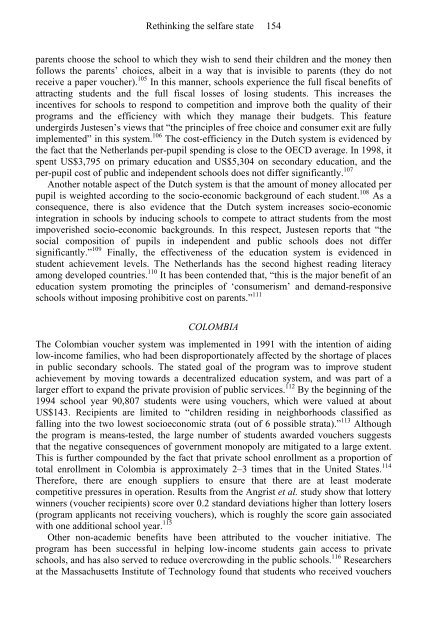Rethinking the Welfare State: The prospects for ... - e-Library
Rethinking the Welfare State: The prospects for ... - e-Library
Rethinking the Welfare State: The prospects for ... - e-Library
Create successful ePaper yourself
Turn your PDF publications into a flip-book with our unique Google optimized e-Paper software.
<strong>Rethinking</strong> <strong>the</strong> selfare state 154<br />
parents choose <strong>the</strong> school to which <strong>the</strong>y wish to send <strong>the</strong>ir children and <strong>the</strong> money <strong>the</strong>n<br />
follows <strong>the</strong> parents’ choices, albeit in a way that is invisible to parents (<strong>the</strong>y do not<br />
receive a paper voucher). 105 In this manner, schools experience <strong>the</strong> full fiscal benefits of<br />
attracting students and <strong>the</strong> full fiscal losses of losing students. This increases <strong>the</strong><br />
incentives <strong>for</strong> schools to respond to competition and improve both <strong>the</strong> quality of <strong>the</strong>ir<br />
programs and <strong>the</strong> efficiency with which <strong>the</strong>y manage <strong>the</strong>ir budgets. This feature<br />
undergirds Justesen’s views that “<strong>the</strong> principles of free choice and consumer exit are fully<br />
implemented” in this system. 106 <strong>The</strong> cost-efficiency in <strong>the</strong> Dutch system is evidenced by<br />
<strong>the</strong> fact that <strong>the</strong> Ne<strong>the</strong>rlands per-pupil spending is close to <strong>the</strong> OECD average. In 1998, it<br />
spent US$3,795 on primary education and US$5,304 on secondary education, and <strong>the</strong><br />
per-pupil cost of public and independent schools does not differ significantly. 107<br />
Ano<strong>the</strong>r notable aspect of <strong>the</strong> Dutch system is that <strong>the</strong> amount of money allocated per<br />
pupil is weighted according to <strong>the</strong> socio-economic background of each student. 108 As a<br />
consequence, <strong>the</strong>re is also evidence that <strong>the</strong> Dutch system increases socio-economic<br />
integration in schools by inducing schools to compete to attract students from <strong>the</strong> most<br />
impoverished socio-economic backgrounds. In this respect, Justesen reports that “<strong>the</strong><br />
social composition of pupils in independent and public schools does not differ<br />
significantly.” 109 Finally, <strong>the</strong> effectiveness of <strong>the</strong> education system is evidenced in<br />
student achievement levels. <strong>The</strong> Ne<strong>the</strong>rlands has <strong>the</strong> second highest reading literacy<br />
among developed countries. 110 It has been contended that, “this is <strong>the</strong> major benefit of an<br />
education system promoting <strong>the</strong> principles of ‘consumerism’ and demand-responsive<br />
schools without imposing prohibitive cost on parents.” 111<br />
COLOMBIA<br />
<strong>The</strong> Colombian voucher system was implemented in 1991 with <strong>the</strong> intention of aiding<br />
low-income families, who had been disproportionately affected by <strong>the</strong> shortage of places<br />
in public secondary schools. <strong>The</strong> stated goal of <strong>the</strong> program was to improve student<br />
achievement by moving towards a decentralized education system, and was part of a<br />
larger ef<strong>for</strong>t to expand <strong>the</strong> private provision of public services. 112 By <strong>the</strong> beginning of <strong>the</strong><br />
1994 school year 90,807 students were using vouchers, which were valued at about<br />
US$143. Recipients are limited to “children residing in neighborhoods classified as<br />
falling into <strong>the</strong> two lowest socioeconomic strata (out of 6 possible strata).” 113 Although<br />
<strong>the</strong> program is means-tested, <strong>the</strong> large number of students awarded vouchers suggests<br />
that <strong>the</strong> negative consequences of government monopoly are mitigated to a large extent.<br />
This is fur<strong>the</strong>r compounded by <strong>the</strong> fact that private school enrollment as a proportion of<br />
total enrollment in Colombia is approximately 2–3 times that in <strong>the</strong> United <strong>State</strong>s. 114<br />
<strong>The</strong>re<strong>for</strong>e, <strong>the</strong>re are enough suppliers to ensure that <strong>the</strong>re are at least moderate<br />
competitive pressures in operation. Results from <strong>the</strong> Angrist et al. study show that lottery<br />
winners (voucher recipients) score over 0.2 standard deviations higher than lottery losers<br />
(program applicants not receiving vouchers), which is roughly <strong>the</strong> score gain associated<br />
with one additional school year. 115<br />
O<strong>the</strong>r non-academic benefits have been attributed to <strong>the</strong> voucher initiative. <strong>The</strong><br />
program has been successful in helping low-income students gain access to private<br />
schools, and has also served to reduce overcrowding in <strong>the</strong> public schools. 116 Researchers<br />
at <strong>the</strong> Massachusetts Institute of Technology found that students who received vouchers


